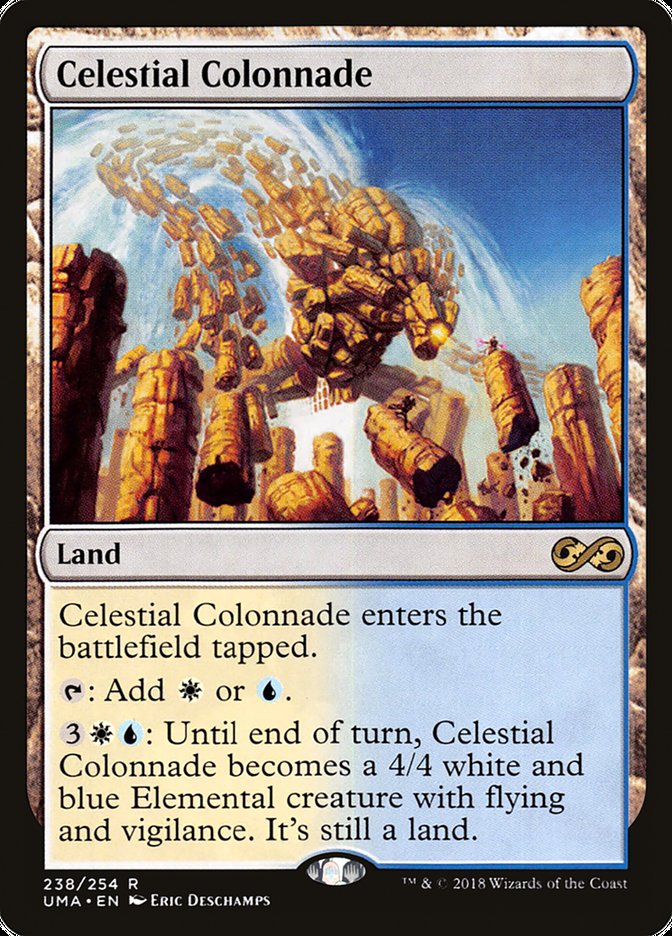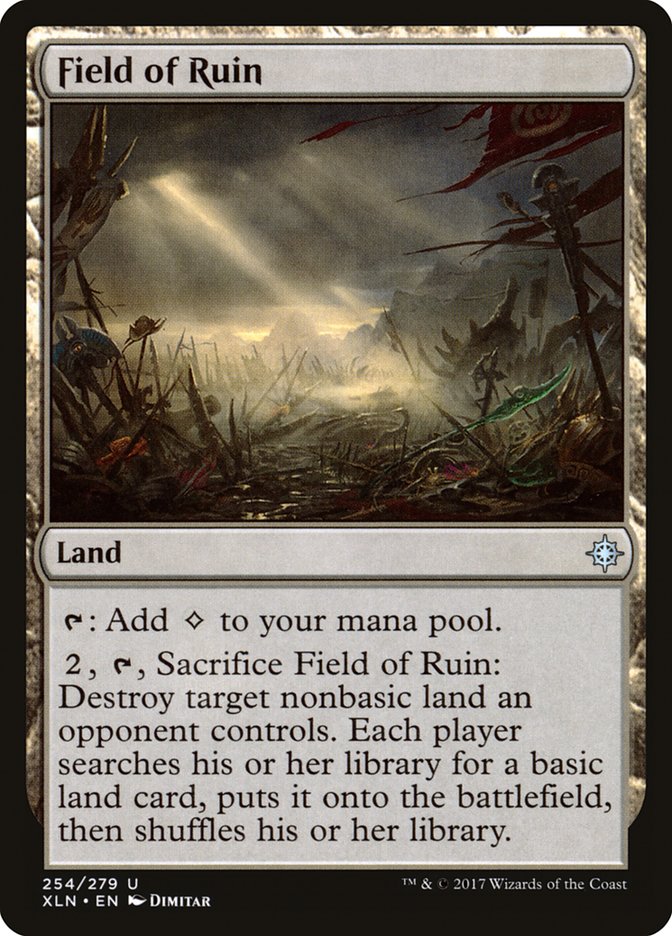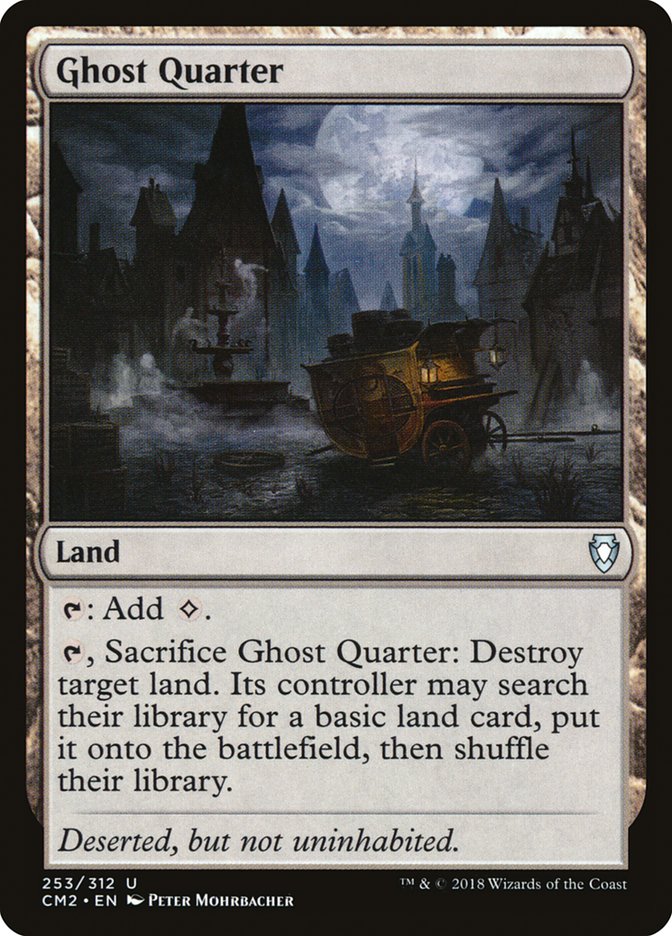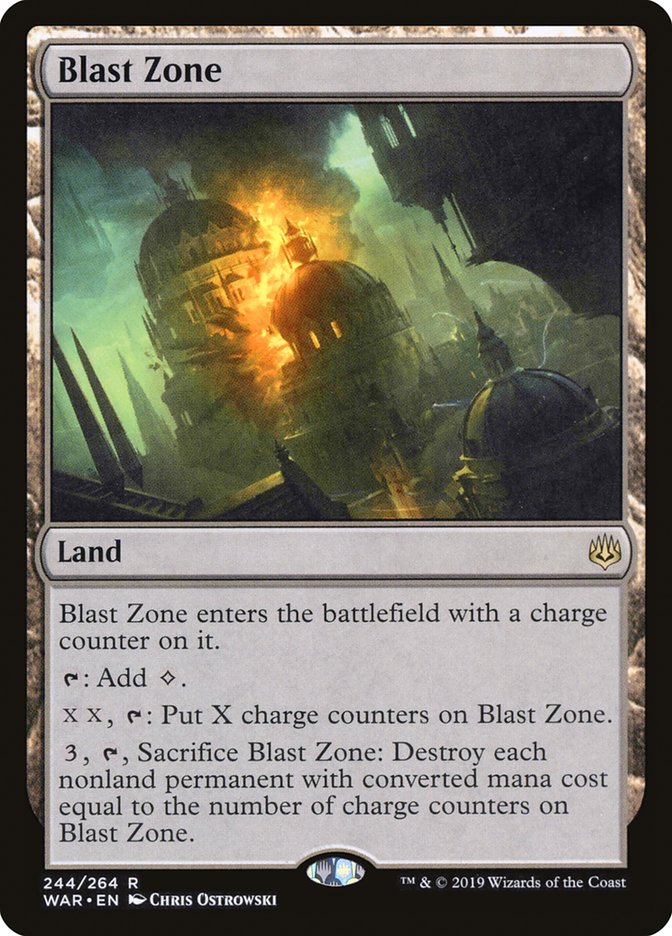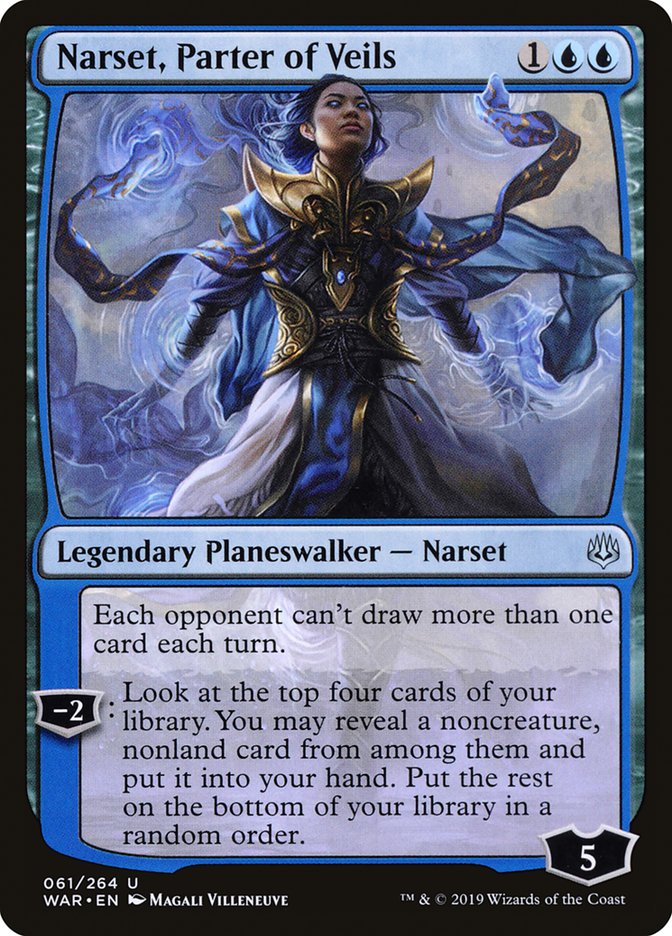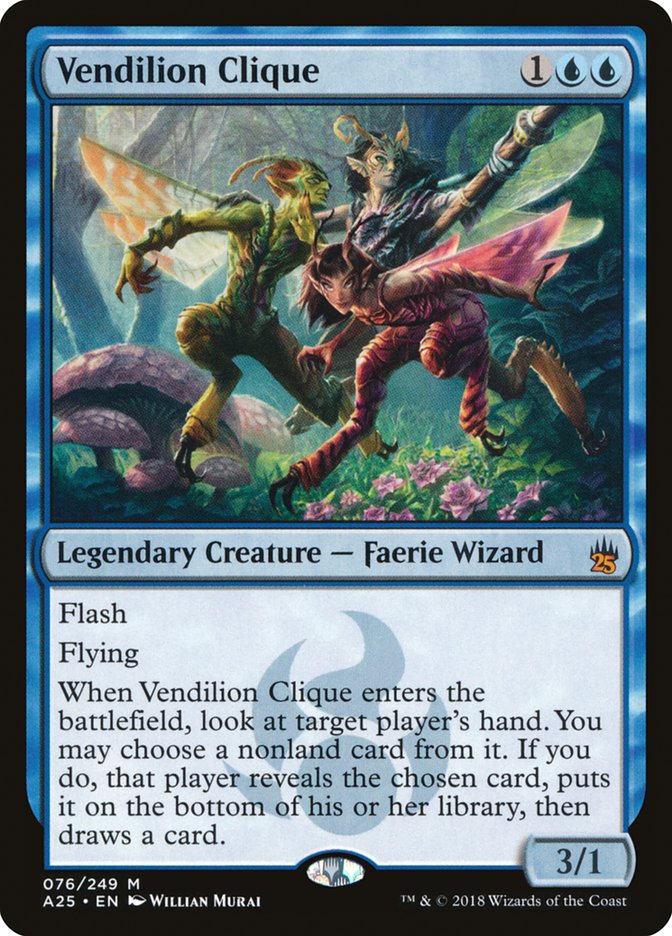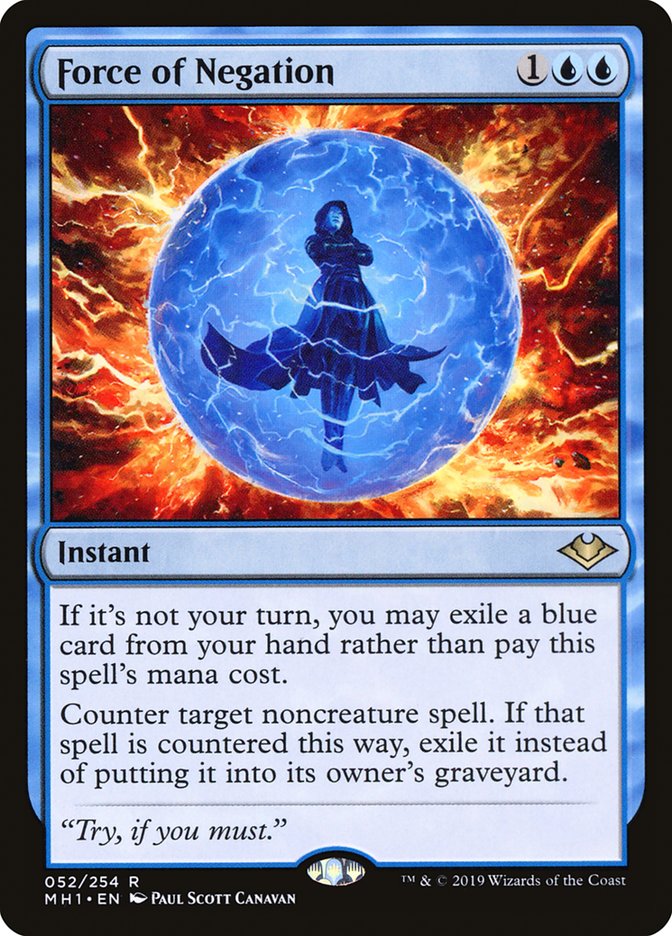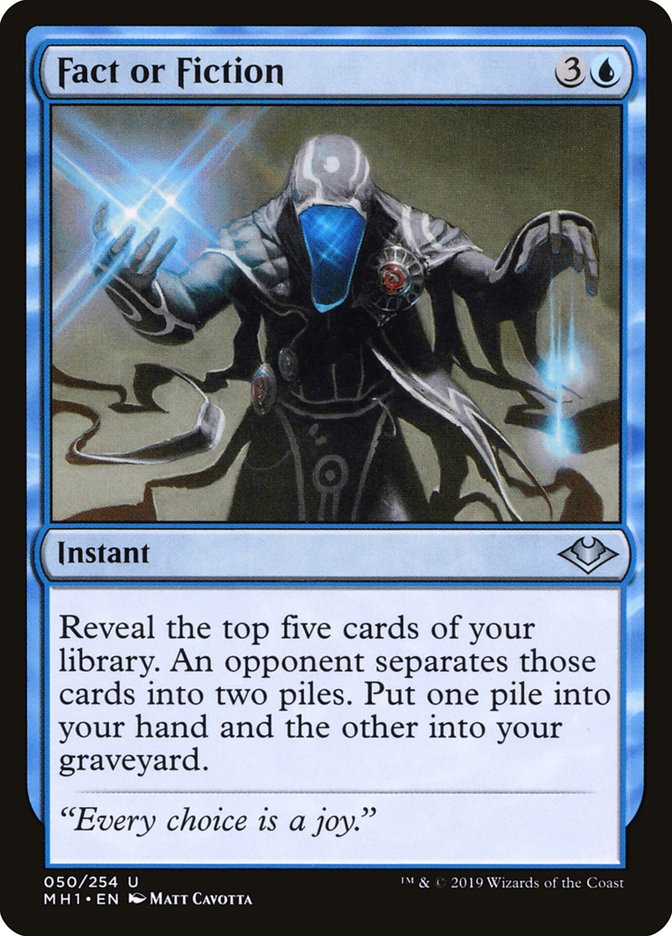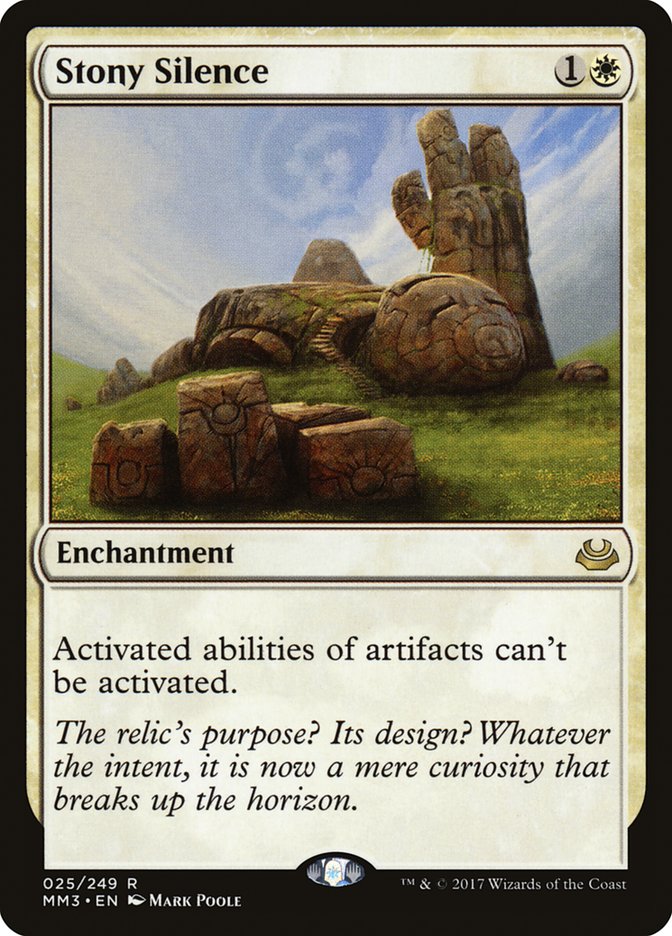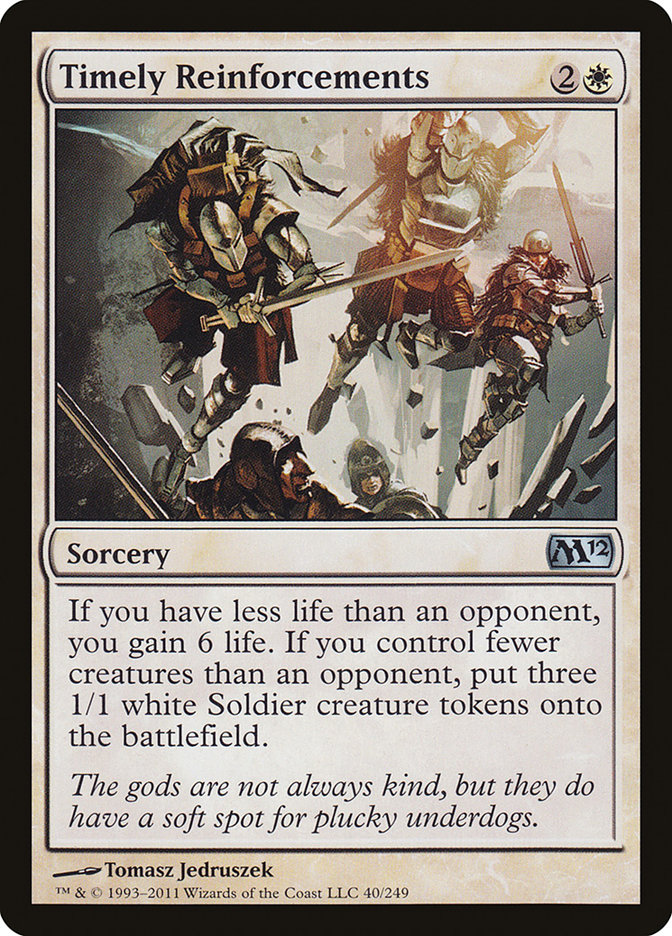Since its inception in 2011, Modern has rewarded linear proactive decks, as control decks have been historically poor in the format relative to other, more proactive options. This is generally because the format has been rather diverse for most of its lifespan, there are several angles of attack present in Tier 1 at any given time, and it’s tough to answer everything at once with only 75 cards.
However, Celestial Colonnade has been the constant.
Nearly every successful control strategy has been base blue and white. Jeskai Control has been around in various forms for nearly the entire duration of the format. Recently, it has been eclipsed in popularity and power level by Azorius Control. A confluence of factors has led to the death of my beloved Lightning Helix / Cryptic Command combo deck. And, while this doesn’t make me particularly happy, it does afford me the opportunity to discuss some interesting trends that have emerged with the introduction of Modern Horizons. Azorius Control is the most powerful fair strategy, and with the introduction of War of the Spark and Modern Horizons, it is poised to be a Top 3 deck in power level.
To understand the new face of Azorius Control, we must first understand the roots. Azorius first solidified itself in the format with the printing of Field of Ruin in late 2017.
Control decks have long struggled with decks that go way over the top. The most common example is Mono-Green Tron. The Azorius-based decks desperately want to be able to interact with the multitude of powerful nonbasic lands in Modern. The opportunity cost of playing Ghost Quarter and Field of Ruin in high enough numbers to be relevant is too high for a three-color deck like Jeskai. Azorius is able to play several copies of these lands while also being able to reliably cast their spells on curve. Pro Tour Rivals of Ixalan in February 2018 saw several Azorius decks post great records in the Modern portion of the event.
Creatures (4)
Planeswalkers (4)
Lands (25)
Spells (27)

This is the list Alex Majlaton piloted to a 9-1 record at Pro Tour Rivals of Ixalan. Notice the four copies of Field of Ruin and Spreading Seas. In addition to playing several counterspells and sweepers, the old Azorius decks employed a land disruption subtheme. At the time, several iterations of Tron were popular, as well as Humans, so Spreading Seas was one of the best cantrip effects you could play. However, it was also a concession to the depth and variety of the format.
Azorius couldn’t always answer every threat, so a proactive approach to the game that involved disrupting the opponent’s mana allowed the control player to beat half or one-third of the opponent’s strategy instead of the whole thing. Taking Humans off red and/or black mana prevented Mantis Rider and Kitesail Freebooter, two of their best cards against control, from being cast. Cutting Grixis Death’s Shadow off red mana eliminates the Temur Battle Rage combo kill as well as preventing Kolaghan’s Command loops with Snapcaster Mage.
Despite having a lot of good things going for it, this deck still had most of the faults of a Modern control deck. It played several situational counterspells and removal that wasn’t absolute. Logic Knot and Negate could be useless against Humans and Detention Sphere could get blown up by a savvy Tron or Jund opponent.
The new face of Azorius emerged with the release of War of the Spark and now Modern Horizons and the deck has changed drastically since Alex’s run in Bilbao in February 2018.
Creatures (4)
Planeswalkers (9)
Lands (25)
Spells (22)

Jeremy Bertarioni is the name behind the next list. A familiar face on the SCG Tour, Jeremy took down the Modern Classic at SCG Syracuse with this take on Azorius Control. It incorporates three new cards from War of the Spark, just two weeks old at that point. These innovations have set the standard for what an Azorius Control deck looks like heading into Modern Horizons.
Blast Zone appears to be the most innocuous of the three new cards that made their mark. After all, Azorius is able to play several colorless utility lands without an appreciable opportunity cost. However, one important thing to consider is that Jeremy is playing nine planeswalkers. His deck has to be slower than other, more reactive versions. Blast Zone gives you a way to mitigate their go-wide draws at the low cost of a land slot.
Teferi, Time Raveler is the current scourge of Standard – though still better than having to deal with Nexus of Fate – but has made his impact in Modern as well. The +1 ability allows you to cast your sweepers, two Supreme Verdict and one Wrath of God, at instant speed. This effectively combats haste creatures and creature-lands, two of the things that have been historically effective against control decks and planeswalkers alike.
The -3 ability lets you draw a card on an empty battlefield while also having the utility of bouncing a wide range of troublesome permanents and getting you closer to hitting your land drops. It’s worth noting that cards like Pithing Needle and Sorcerous Spyglass are rather poor against this deck for two reasons: the planeswalkers have static abilities, and both Teferis can remove the artifacts in question.
The static ability prevents opponents from playing at instant speed against you. This is obviously great against other blue decks but also really shines against tricky decks like Burn and Infect. Teferi is especially good after sideboard against Izzet Phoenix. Phoenix usually has fewer Lightning Bolts and more reactive cards like Spell Pierce in their configuration after sideboarding. If you can get Teferi onto the battlefield, he will give them a lot of trouble. He completely shuts down Finale of Promise, a card that both Izzet and Mono-Red Phoenix play in multiples and will likely never trim against Azorius Control.
Despite the impact of Teferi being huge, he’s not even the most important addition to the deck.
Narset, Parter of Veils has drastically changed every Constructed format she’s legal in. All your best answers and all your best threats can be found with the Azcanta, the Sunken Ruin -2 ability and the static ability counteracts one of the best ways to fight control – traditional card advantage. This card also completely hoses Izzet Phoenix, the de facto best deck in Modern. Against Izzet, it can be right to play Narset and not activate the minus ability, thus keeping your ‘walker out of reach of a Lightning Bolt.
This dynamic also draws attention to another interesting decision point. You’re playing a control deck. The main goal of a control deck is to stay alive. Your deck is packed with inevitability and the game will usually favor you the longer it goes. Narset does almost completely stop Izzet Phoenix from functioning. In the cases where it doesn’t do this, your Narsets and other ‘walkers provide a source of lifegain. It might be prescient to keep a certain walker alive in a certain matchup, but you don’t need any specific planeswalker to win the game in the abstract. They all serve to exhaust opponents’ resources.
To this end, getting value out of your ‘walkers is good, even if they die. Don’t be afraid to expose Narset to a Lightning Bolt or an attack because everything is fueling the end goal of staying alive. Narset is also a four-of because it functions like Dig Through Time used to, as it allows you to play fewer copies of certain cards and allows you to more reliably access sideboard cards, provided that they’re not creatures or lands.
A few more interesting aspects of Jeremy’s deck include the maindeck Surgical Extraction, a concession to Dredge and Izzet Phoenix in Tier 1, and the one Vendilion Clique in the maindeck, which has been relatively stock throughout the lifespan of Azorius Control. It’s worth noting that the Clique is interesting because of what it does to opponents when Narset is on the battlefield. If you Clique them on their own turn, they won’t be able to draw another card, so their card will just get placed on the bottom.
Lastly, Jeremy’s sideboard is built with the intention of facing other decks running Dovin’s Veto, Negate, or Spell Pierce and making them look silly. Restoration Angel and Spell Queller do a fine job of this, catching opponents off-guard after sideboard, with Restoration Angel in particular doing a great job of protecting planeswalkers as well as interacting favorably with the maindeck Vendilion Clique and three maindeck Snapcaster Mages.
The Prerelease of Modern Horizons last weekend has lined up with the release of the set on Magic Online. That means this weekend’s Modern Challenge featured Modern Horizons cards for the first time. The result was a bunch of Bridgevine decks featuring Hogaak, Arisen Necropolis, with seven in the Top 16. Lurking amidst this pile of Hogaak decks is an update to Jeremy Bertarioni’s Azorius Control deck that looks pretty good.
Creatures (6)
Planeswalkers (7)
Lands (25)
Spells (22)

Modern Horizons has made its presence felt even in the fairest of decks.
Force of Negation is no Force of Will, but it’s way better than most people think it is. The card allows you to protect your planeswalkers from sorcery-speed removal. More importantly, it stops you from dying on Turn 1 or Turn 2 to some Allosaurus Rider / Neoform nonsense. Planeswalkers are much, much better in a deck like this because the cost of tapping out used to be prohibitively high, since control decks scramble to hit every land drop while hoping their permission lined up favorably. Now you’re protected from a combo or an opposing planeswalker by Force of Negation. The two maindeck Surgical Extractions also serve as additional free reactive effects in some matchups, making this a control deck that takes a proactive role by jamming planeswalkers until you’ve soft-locked your opponent while safely being able to tap out.
The differences between the SoulStrong list and Bertarioni’s list from the Syracuse Modern Classic aren’t numerous. Everything feels different because of the introduction of Modern Horizons, and with it, Hogaak, but not much has changed. Force of Negation replaced a Dovin’s Veto, a Narset got trimmed, the Hieroglyphic Illumination got cut, a second Surgical got added. Most of the changes are fairly subtle, but the removal of Hieroglyphic Illumination was for a much more robust card:
Everyone’s favorite card advantage spell from the early 2000s is back! It’s nice that Fact or Fiction doesn’t actually draw cards, thus circumventing opposing Narsets, and it pairs nicely with Cryptic Command, giving you a great option on four when you’d rather not cast the Cryptic. A +1 from Teferi, Time Raveler also allows you to Fact or Fiction or Wrath of God / Supreme Verdict with the same four mana. Blast Zone also works nicely with this card, as you can charge if needed and spend the mana wisely to draw some cards if you don’t have to sink the mana into the powerful land.
To go slightly deeper, it’s incredibly powerful to have three sweepers in your deck when you also play Fact or Fiction, as you’ll end up with some four-one piles to really take advantage of. When you also consider that you play four copies of Snapcaster Mage, the reality is that opponents will often level themselves into letting you draw four. Fact or Fiction isn’t heinously overpowered but it has some nice synergies with your mana curve and your Snapcasters. This format is probably too fast for Search for Azcanta, but it is worth nothing that Fact or Fiction can turbo-charge a transformation into Azcanta, the Sunken Ruin…
The sideboard is mostly the same as Jeremy’s from Syracuse, but has added a second copy of Teferi, Time Raveler over a Surgical Extraction that got moved to the maindeck. This is likely a reaction to the introduction of Finale of Promise to various Arclight Phoenix strategies.
One of the final main strengths of Azorius is that it can play the best, most polarizing sideboard cards.
The two-mana enchantments are fantastic in the matchups that warrant their inclusion and can be solid value plays against other decks. For example, Rest in Peace is for Dredge, Bridgevine, and Izzet Phoenix, yet hoses Grixis Death’s Shadow almost by accident. The deck becomes much easier to beat when they don’t have cheap delve threats or Snapcasters for late redundancy. Granted, it also nixes your Snapcasters, but you can win without them and either card is usually a must-take with Inquisition of Kozilek or Thoughtseize. Against the dedicated graveyard decks, it’s great to have a ton of interaction to ensure you draw something that matters.
Stony Silence is a silver bullet against Affinity, Hardened Scales, and Lantern Control but also gives some trouble to Mono-Green Tron, since it shuts off all their Chromatic Stars and Spheres as well as Oblivion Stone. Oblivion Stone is actually good against you because you have so many permanents in this new version of Azorius Control.
Timely Reinforcements against Burn at instant speed from Teferi is the type of thing that gets me all worked up. It eliminates the element of the matchup that was essentially dancing around their Skullcracks until you could find a window to gain some much-needed life. Now you can cast Timely whenever and they can’t respond, and even if the opponent kills Teferi, it’s fairly likely that they had to tap out or tap low to do so.
It’s Azorius’s Time to Shine
I think the sky is far from falling in Modern. Bridgevine is quite obviously broken nonsense and Hogaak is likely a mistake, but Azorius has a fine suite of weaponry to combat it and doing so won’t cost you your matchup against the rest of the format. I’ve recently tried to curb my penchant for registering Celestial Colonnade no matter what, but I’m also very tempted to sleeve up this or something like it for my next Modern event.
Force of Negation is just what control needed to keep pace and I can’t wait to see how all these changes shake out over the next few months!


